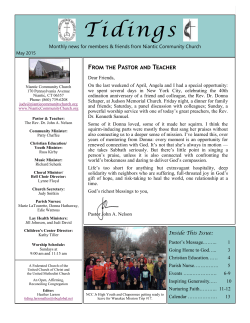
What is Killing the Eelgrass in the Niantic River Estuary?
What is Killing the Eelgrass in the Niantic River Estuary? A Biogeochemical Study of Eutrophication John P. Jasper Niantic River Watershed Organization And Nature’s Fingerprint® / MIT LLC Niantic, CT (March 9, 2010) The Niantic River Watershed The Niantic River Estuary (USGS, 1983) General Model: Nutrient Sources Unspecified (Barrow, 2009) Estuarine Circulation and the Nutrient Trap Freshwater Brackish Water: Out at surface. Nutrient Trap Oceanic Saltwater In at bottom. Examples of Estuarine Circulation: 1. Riverine estuaries. 2. Coastal upwelling zones. 3. Global ocean. Estuarine Chemistry and Mixing: PO4 vs Salinity: Conservative Mixing Line Clyde Estuary, Scotland Removal Nutrient Trap (Mackay & Leatherland, 1976) Niantic River, Summer 2000: PO4 vs. Salinity (0-28 psu) 1.4 1.2 PO4 (µM) 1.0 0.8 5-Jun 28-Jun 0.6 28-Jul 17-Aug 0.4 0.2 0.0 X 0 (Latimer Brook, 0.5-1.5 µM, USGS) 3 6 9 12 15 18 21 24 27 30 Salinity (psu) (Data from Vaudrey, 2007, and USGS) 3.5 NO3+NO2 (µM) 3.0 X X NO3 + NO2 vs Salinity (0-28 psu) 0Groundwaters, ( ~0-280 µM) Niantic River Summer 2000 Latimer Brook, (3-8 µM, USGS) 2.5 5-Jun 2.0 28-Jun 1.5 7/28 1.0 17-Aug ? 0.5 0.0 0 10 20 Salinity (psu) 30 (Data from Vaudrey, 2007, and USGS) Niantic River Periphery: Groundwater NO3 + NO2 East Side of the NR: Waterford 2 ] µM West Side of the NR: East Lyme (#1) (Vaudrey & Kremer, 2007) Niantic River Model Riverine & Groundwater Sources X X Oceanic Source (Modified from Barrow, 2009) Nutrient (N, P) Budget of the Niantic River Estuary Freshwater End Member (+xs NOx) Brackish Water (+NOx, -PO4) CNPinorg -> CNPorg Eelgrass Saltwater Oceanic End Member CNPorg PO4 (Net Import of PO4: NOx (Net Export of NOx: In: 0.90 µM; Out: 0.75 µM.) In: 0.80 µM; Out: 0.73 µM) Biogeochemical Circulation of the Niantic River Estuary Freshwater Brackish Water (Lower SO4) (+NOx) TOM MOM TOM + MOM = SOM SO4 + SOM = H2S + SOMox Eelgrass Saltwater (High SO4) (PO4) 2 “CH2O” + SO42- H2S + 2 HCO3Question: What type of organic matter – terrigenous or marine – drives H2S production that kills eelgrass? Net Estuarine Nutrient Circulation: Historical Changes a. Nin b. Nin Pin Pre-Industrial MOM Pin Nin Anthropogenic: excess N,P. (Pre-1980s) MOM Nout Pin Pout Anthropogenic: P mitigated (Post-1980s) Nout MOM c. Nin Pin Pin Summary: A Working Hypothesis A simple biogeochemical model of the circulation of the Niantic River Estuary (NRE) has been developed from NR data. A eutrophic ‘nutrient trap’ (typical of estuarine circulation) works as follows: 1. Nutrients: a. PO4 enters the NRE from the Long Island Sound (the oceanic end member); b. NOx enters the NRE from three brooks and through ground waters (the terrigenous end members). 2. Sedimentary Organic Matter (SOM): a. Marine Organic Matter (MOM) is produced with water-column nutrients; b. Terrigenous Organic Matter (TOM) runs off from the land, amplified by riparian erosion. 3. Hydrogen Sulfide inhibits or kills Eelgrass (Zostera sp.): a. Seawater (LIS) SO4 enters the NRE and is reduced to H2S in sediments; b. The H2S (perhaps in reducing sediment particles) is transported to the Eelgrass beds where it impacts the Eelgrass. Niantic River Estuary: Sub-bottom Profiling Track and Sediment Core Locations Acknowledgements Donald F. Landers Millstone Environmental Laboratories Sarah Lamagna Eastern Connecticut Conservation District Prof. Frank Bohlen Department of Marine Science University of Connecticut Prof. Robert Howarth Department of Ecology & Evolutionary Biology Cornell University Eutrophication: Sedimentary History
© Copyright 2025





















